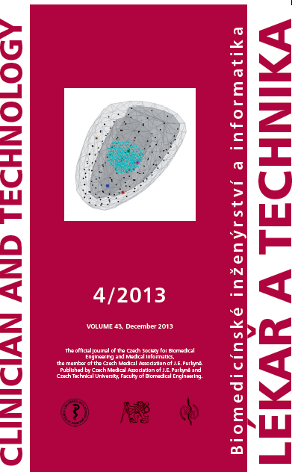VÝVOJOVÉ PORUCHY ZUBŮ A JEJICH DIAGNOSTIKA POMOCÍ RENTGENOVÝCH SNÍMKŮ
Keywords:
malformation of tooth, X-ray examination, tooth development, DDE, AFMAbstract
Introduction: The Development of detention begins in sixth week of intrauterine life with making the dentogingival lamina, that gives the origin to tooth germs. If the insult operates in these early stages of development, it can result in termination of the development of tooth, the disorder in later development manifests as a malformation of tooth - the anomaly of shape, size, defects of hard dental tissues, variations in eruption, etc. The development of tooth is related to the development of the whole organism, therefore the failure of the overall development interferes with the development of teeth. Except for systemic disorders, factors as trauma and inflammation may play a significant role. The differentiation between local and systemic causes of the anomaly can be very difficult. Methods: An indispensable component in diagnostic and as a tool for screening of disorders of impacted teeth is the radiographic examination. In dentistry we use intraoral RVG images, OPG panoramic image and for 3D imaging CBCT and CT. Results: Atomic force microscopy(AFM) was used to study the enamel surface of extracted teeth in order to compare the structure of malformed and healthy enamel. Conclusion: Developmental disorders of the teeth and dental hard tissues are relatively common clinical practice and their diagnostics and therapy is usually not an easy task. It is often found as an incidental finding on chest radiograph. Atomic force microscopy provides high-resolution images and is an important source of information about the structure of human enamel.Downloads
Published
Issue
Section
License
Copyright (c) 2017 E. Kaplová, P. Krejčí, K. Tománková, H. Kolářová, L. Kramerová

This work is licensed under a Creative Commons Attribution 4.0 International License.
Authors who publish with this journal agree to the following terms:
- Authors retain copyright and grant the journal right of the first publication with the work simultaneously licensed under a Creative Commons Attribution License (https://creativecommons.org/licenses/by/4.0/) that allows others to share the work with an acknowledgment of the work's authorship and initial publication in CTJ.
- Authors are able to enter into separate, additional contractual arrangements for the non-exclusive distribution of the journal’s published version of the work (e.g., post it to an institutional repository or publish it in a book), with an acknowledgment of its initial publication in this journal.
- Authors are permitted and encouraged to post their work online (e.g., in institutional repositories or on their website or ResearchGate) prior to and during the submission process, as it can lead to productive exchanges.
CTJ requires that all of the content of the manuscript has been created by its respective authors or that permission to use a copyrighted material has been obtained by the authors before submitting the manuscript to CTJ. CTJ requires that authors have not used any copyrighted material illegally, as for example a picture from another journal or book, a photo, etc. It is the author’s responsibility to use only materials not violating the copyright law. When in doubt, CTJ may ask the authors to supply the pertinent permission or agreement about the use of a copyrighted material.
The opinions expressed in CTJ articles are those of authors and do not necessarily reflect the views of the publishers or the Czech Society for Biomedical Engineering and Medical Informatics.


